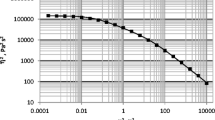Summary
The rheological properties (shear and normal stresses and high-elastic deformations) of low-molecular-weight polyisobutylene, a typical viscoelastic liquid, were studied.
Investigation of the character of development of stresses and deformation at a given constant shear rate show that the only criterion of attainment of steady-state flow condition is constancy of the normal stresses. Not one of the known theories gives a correct description of the relationship between the stresses and elastic deformations at transient (pre=steady=state) deformation regimes.
A study of steady-state flow regimes has shown that within a wide range of shear rates, in both the linear and the nonlinear regions, the normal stresses are proportional to the square of the shear stresses.Lodges theory, which relates the halved ratio of normal to shear stresses with the elastic deformations, is valid only in the region of Newtonian flow. The question of the interrelation between the relaxation spectrum and the normal stresses (in the linear region) is discussed in detail, making use of independent measurements of the frequency dependence of the dynamic moduli.
The temperature dependences of the parameters characterizing the viscoelastic properties of the liquid studied are discussed in detail, these parameters being: the initial (Newtonian) viscosity, the coefficient of normal stresses, and the high elastic deformations. The dependence of the high elastic deformations on the shear stress and the temperature are not described by the entropy theory of high elasticity owing to the change in internal energy of the system on development of viscous flow.
Zusammenfassung
Die rheologischen Eigenschaften (Schub- und Normalspannungen sowie hochelastische Verformungen) von niedermolekularen Polyisobutylenen, einer typischen viskoelastischen Flüssigkeit, werden untersucht.
Eine Untersuchung des Charakters der Entwicklung von Spannungen und Verformungen bei einer gegebenen konstanten Schergeschwindigkeit zeigt, daß das einzige Kriterium zur Erzielung eines stationären Fließzustandes die Konstanz der Normalspannungen ist. Nicht eine der bekannten Theorien gibt eine richtige Beschreibung der Beziehung zwischen den Spannungen und elastischen Verformungen im Übergangsbereich.
Eine Untersuchung der stationären Fließbedingungen hat gezeigt, daß innerhalb eines weiten Bereichs von Schergeschwindigkeiten die Normalspannungen dem Quadrat der Scherspannungen proportional sind. Die Theorie vonLodge gilt nur im Bereich des Newtonschen Fließens. Die Frage der Wechselbeziehung zwischen dem Relaxationsspektrum und den Normalspannungen (im linearen Bereich) wird im einzelnen diskutiert, wobei von unabhängigen Messungen der Frequenzabhängigkeit der dynamischen Moduln Gebrauch gemacht wird.
Die Temperaturabhängigkeiten der Bestimmungsgrößen, die die viskoelastischen Eigenschaften der untersuchten Flüssigkeit kennzeichnen, werden im einzelnen besprochen. Die Bestimmungsgrößen, um die es sich handelt, sind die Anfangs-(Newtonsche) Viskosität, der Normalspannungskoeffizient und die hochelastischen Verformungen. Die Abhängigkeit der hochelastischen Verformungen von der Schubspannung und der Temperatur wird von der Entropietheorie für hohe Elastizität nicht beschrieben, und zwar wegen der Veränderung der inneren Energie des Systems bei der Ausbildung des viskosen Fließens.
Similar content being viewed by others
References
Fox, T. G. andP. Y. Flory, J. Phys. Colloid Sci.55, 221 (1951).
Vinogradov, G. V., A. Ya. Malkin andV. F. Shumsky, Vysokomolekul. Soedin.10 A, 2672 (1968).
Vinogradov, G. V., A. Ya. Malkin, M. P. Zabugina andV. F. Shumsky, Vysokomolekul. Soedin. (in press).
Shumsky, V. F. andA. Ya. Malkin, Zavodsk. Lab.34, 1389 (1968).
Gross, B., Mathematical Structure of the Theories of Viscoelasticity (Paris 1953).
Fredrickson, A. G., Chem. Eng. Sci.17, 155 (1962).
Malkin, A. Ya., Rheol. Acta7, 335 (1968).
Vinogradov, G. V. andI. M. Belkin, J. Polymer Sci.,3 A, 917 (1965).
Mustafayev, E., A. Ya. Malkin, E. P. Plotnikova, G. V. Vinogradov, Vysokomolekul. Soedin.6, 1516 (1964).
Vinogradov, G. V. andA. Ya. Malkin, J. Polymer Sci.2 A, 2357 (1964).
Malkin, A. Ya. andG. V. Vinogradov, J. Appl. Polymer Sci.10, 767 (1966).
Treloar, L. R. G., The Physics of Rubber Elasticity (Oxford 1954).
Philippoff, W. andF. H. Gaskins, Trans. Soc. Rheol.2, 263 (1958).
Bagley, E. B., J. Appl. Phys.31, 1126 (1960).
Kuroiwa, S., andM. Nakamura, Chem. High Polymers (Japan),24, 529 (1967).
Philippoff, W., F. H. Gaskins andJ. G. Brodnyan, J. Appl. Phys.28, 1118 (1957); Trans. Soc. Rheol.1, 109 (1957).
Philippoff, W., Viscoelasticity and its application to lubrication, ASME-ASTM-ASLE Symposium, Ann Arbor, Michigan, March 18, 1968.
Philippoff, W., Trans. Soc. Rheol.10, 11 (1966).
Meissner, J., Kunststoffe,57, 702 (1967).
Lodge, A. S., Elastic Liquids (Oxford 1964).
Jobling, A. andJ. E. Roberts, in Rheology, ed.F. Eirich 2, 503 (1958).
Khanna, S. K. andW. F. O. Pollett, J. Appl., Polymer Sci.9, 1761 (1965).
Benbow, J. J. andE. R. Howells, Polymer2, 429 (1961).
King, R. G., Rheol. Acta5, 35 (1966).
Morozov, A. S., in:I. M. Belkin, G. V. Vinogradov andA. I. Leonov, Rotary Instruments for Measuring the Viscosity and Physicomechanical Characteristics of Materials, Ch. 3 (Moscow 1968).
Author information
Authors and Affiliations
Rights and permissions
About this article
Cite this article
Vinogradov, G.V., Malkin, A.Y. & Shumsky, V.F. High elasticity, normal and shear stresses on shear deformation of low-molecular-weight polyisobutylene. Rheol Acta 9, 155–163 (1970). https://doi.org/10.1007/BF01973473
Received:
Issue Date:
DOI: https://doi.org/10.1007/BF01973473



